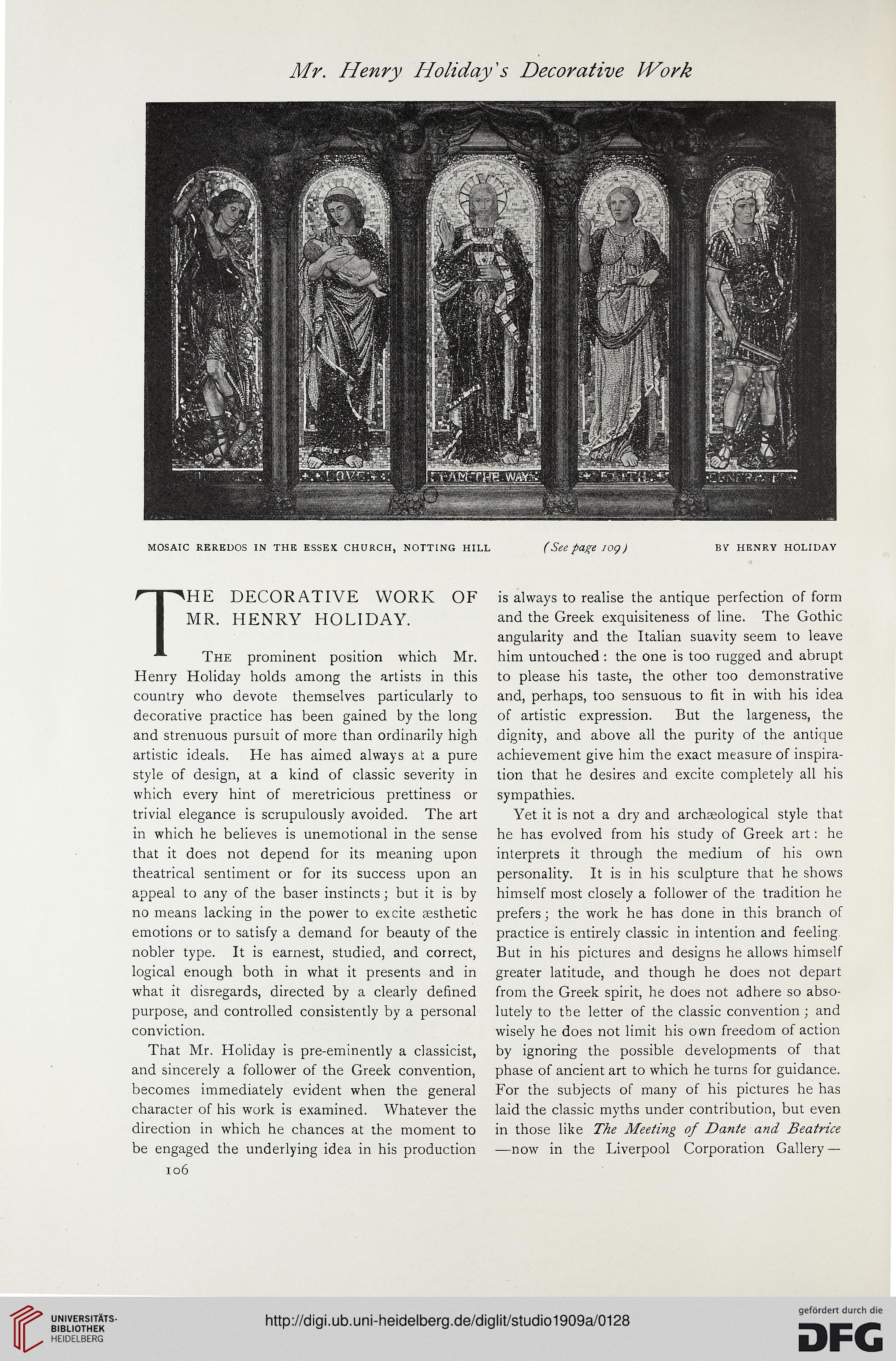Mr. Henry Holiday's Decorative IVork
MOSAIC REREDOS IN THE ESSEX CHURCH, NOTTING HILL (See page 10Q ) BY HENRY HOLIDAY
T
HE DECORATIVE WORK OF
MR. HENRY HOLIDAY.
The prominent position which Mr.
Henry Holiday holds among the artists in this
country who devote themselves particularly to
decorative practice has been gained by the long
and strenuous pursuit of more than ordinarily high
artistic ideals. He has aimed always at a pure
style of design, at a kind of classic severity in
which every hint of meretricious prettiness or
trivial elegance is scrupulously avoided. The art
in which he believes is unemotional in the sense
that it does not depend for its meaning upon
theatrical sentiment or for its success upon an
appeal to any of the baser instincts; but it is by
no means lacking in the power to excite aesthetic
emotions or to satisfy a demand for beauty of the
nobler type. It is earnest, studied, and correct,
logical enough both in what it presents and in
what it disregards, directed by a clearly defined
purpose, and controlled consistently by a personal
conviction.
That Mr. Holiday is pre-eminently a classicist,
and sincerely a follower of the Greek convention,
becomes immediately evident when the general
character of his work is examined. Whatever the
direction in which he chances at the moment to
be engaged the underlying idea in his production
106
is always to realise the antique perfection of form
and the Greek exquisiteness of line. The Gothic
angularity and the Italian suavity seem to leave
him untouched : the one is too rugged and abrupt
to please his taste, the other too demonstrative
and, perhaps, too sensuous to fit in with his idea
of artistic expression. But the largeness, the
dignity, and above all the purity of the antique
achievement give him the exact measure of inspira-
tion that he desires and excite completely all his
sympathies.
Yet it is not a dry and archaeological style that
he has evolved from his study of Greek art: he
interprets it through the medium of his own
personality. It is in his sculpture that he shows
himself most closely a follower of the tradition he
prefers; the work he has done in this branch of
practice is entirely classic in intention and feeling
But in his pictures and designs he allows himself
greater latitude, and though he does not depart
from the Greek spirit, he does not adhere so abso-
lutely to the letter of the classic convention; and
wisely he does not limit his own freedom of action
by ignoring the possible developments of that
phase of ancient art to which he turns for guidance.
For the subjects of many of his pictures he has
laid the classic myths under contribution, but even
in those like The Meeting of Dante and Beatrice
■—now in the Liverpool Corporation Gallery —
MOSAIC REREDOS IN THE ESSEX CHURCH, NOTTING HILL (See page 10Q ) BY HENRY HOLIDAY
T
HE DECORATIVE WORK OF
MR. HENRY HOLIDAY.
The prominent position which Mr.
Henry Holiday holds among the artists in this
country who devote themselves particularly to
decorative practice has been gained by the long
and strenuous pursuit of more than ordinarily high
artistic ideals. He has aimed always at a pure
style of design, at a kind of classic severity in
which every hint of meretricious prettiness or
trivial elegance is scrupulously avoided. The art
in which he believes is unemotional in the sense
that it does not depend for its meaning upon
theatrical sentiment or for its success upon an
appeal to any of the baser instincts; but it is by
no means lacking in the power to excite aesthetic
emotions or to satisfy a demand for beauty of the
nobler type. It is earnest, studied, and correct,
logical enough both in what it presents and in
what it disregards, directed by a clearly defined
purpose, and controlled consistently by a personal
conviction.
That Mr. Holiday is pre-eminently a classicist,
and sincerely a follower of the Greek convention,
becomes immediately evident when the general
character of his work is examined. Whatever the
direction in which he chances at the moment to
be engaged the underlying idea in his production
106
is always to realise the antique perfection of form
and the Greek exquisiteness of line. The Gothic
angularity and the Italian suavity seem to leave
him untouched : the one is too rugged and abrupt
to please his taste, the other too demonstrative
and, perhaps, too sensuous to fit in with his idea
of artistic expression. But the largeness, the
dignity, and above all the purity of the antique
achievement give him the exact measure of inspira-
tion that he desires and excite completely all his
sympathies.
Yet it is not a dry and archaeological style that
he has evolved from his study of Greek art: he
interprets it through the medium of his own
personality. It is in his sculpture that he shows
himself most closely a follower of the tradition he
prefers; the work he has done in this branch of
practice is entirely classic in intention and feeling
But in his pictures and designs he allows himself
greater latitude, and though he does not depart
from the Greek spirit, he does not adhere so abso-
lutely to the letter of the classic convention; and
wisely he does not limit his own freedom of action
by ignoring the possible developments of that
phase of ancient art to which he turns for guidance.
For the subjects of many of his pictures he has
laid the classic myths under contribution, but even
in those like The Meeting of Dante and Beatrice
■—now in the Liverpool Corporation Gallery —





